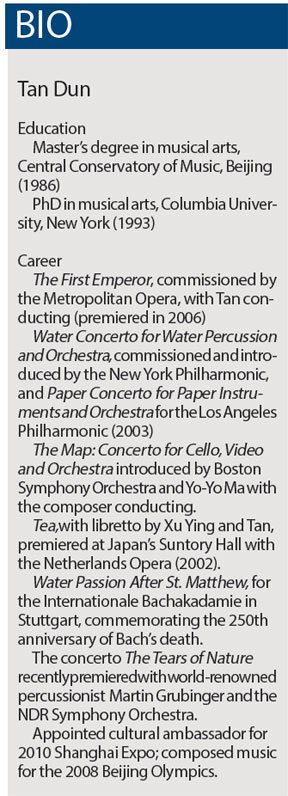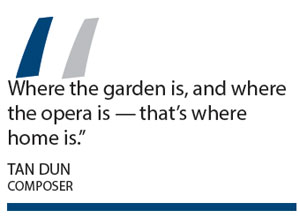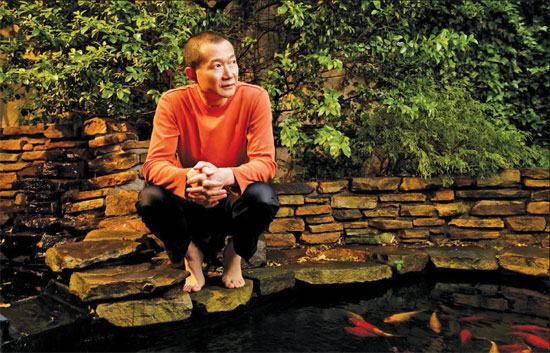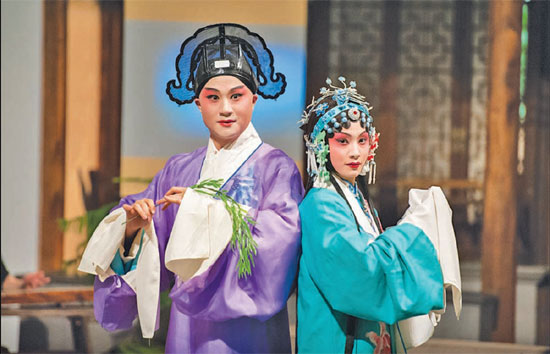Operatic dream blossoms
Updated: 2013-01-11 12:22
By Liu Yuhan (China Daily)
|
||||||||
|
Composer Tan Dun's love for traditional Chinese culture is revealed in his work, most recently the garden-based version of The Peony Pavilion, a classic of Kunqu opera from the 16th century. Provided to China Daily |
Music has taken Tan Dun from busking on Manhattan streets to an Academy Award, but his love of traditional Chinese culture, especially gardens and Kunqu opera, has been constant, Liu Yuhan reports from New York.
By setting the Kunqu opera The Peony Pavilion among the Chinese gardens in New York's Metropolitan Museum of Art, composer Tan Dun breathed new life into the 16th-century work - affirming its epic status while infusing it with timeless lyricism.
Co-produced by the Met and the US-China Cultural Institute, Tan's version used lush backdrops from the eight-gallery Chinese Gardens exhibit in the museum's Astor Court. The exhibit, now closed, explored 1,000 years of rich interaction between pictorial and garden arts in China.
The Met's Astor Court, opened in 1981, was the first authentic Ming Dynasty-style garden built outside of China. This early example of China-US cultural exchange is modeled on a courtyard in the Master of the Fishing Nets garden in Suzhou, in eastern China's Jiangsu province. The original, built in the 12th century and restored in 1785, is recognized as a World Heritage Site by the United Nations Educational, Scientific and Cultural Organization.

"Doing The Peony Pavilion - about love, life and the future in retrospect, so to speak - is very meaningful to me, and it's very meaningful to traditional Chinese Kunqu opera and garden culture," said Tan, who is best known for winning the Academy Award for Best Original Score for the 2000 film Crouching Tiger, Hidden Dragon.
The Peony Pavilion, written by Tang Xianzu during the late stages of the Ming Dynasty (1368-1644), was first performed in 1598 and has come to be regarded as the most important work of Kunqu opera. At its core is a love story between characters Liu Mengmei and Du Liniang. The latter walks in the garden and falls asleep. In her dreams, Du encounters Liu as a young scholar. She has never met this man in real life but falls deeply in love with him nonetheless. When Du wakes up, she becomes preoccupied with her dream affair but soon dies of lovesickness, leaving only her portrait behind. Liu, on his way to take a high-stakes exam to join the emperor's civil service, passes by the garden of their dream liaisons. He sees Du's picture and falls in love with it. Liu later digs up the girl's corpse; she later comes back to life and the pair eventually unite in "real life".
In its original form, the opera can last 20 hours. The scale is monumental, but so is Tan's efficient distillation of dream imagery and seemingly supernatural elements, said Maxwell Hearn, the Met's curator of Asian art.
Kunqu is one of China's oldest surviving opera forms. Characterized by musical performances combined with complex choreography, it dominated other kinds of Chinese theater between the 16th and 18th centuries. Its influence has earned Kunqu the distinction as the "mother" of other forms of Chinese opera, including the world-famous Peking.
After the People's Republic of China was founded in 1949, the government began efforts to bolster opera by training professionals for traditional theaters and establishing specialized arts research institutes. Within two decades, the "cultural revolution" (1966-76) had ended these efforts. Then, in the early 1980s, the Chinese Ministry of Culture called on actors trained in Kunqu opera to resume their work.
But reviving the venerable form has encountered challenges - a lack of playwrights with fresh ideas, the loss of documentation about Kunqu plays (only about 10 are regularly performed, compared with 800 during Kunqu's glorious past), insufficient funding for Kunqu theaters and a sharply decreasing number of students who pursue the form as a career. By the early 20th century, Kunqu was on the verge of disappearing.
At the start of the 21st century, UNESCO designated Kunqu opera "a masterpiece of the oral and intangible heritage of humanity".Tan said he hopes his devotion to The Peony Pavilion can help restore the form to prominence.
"Kunqu opera is so much about talking and singing; it's beautiful and classical. It's even a few hundred years older than Peking opera," Tan told China Daily. "But this beautiful, traditional art form is gradually being forgotten."
The Oscar-winning artist said his idea for reviving the most famous work of Kunqu came in 2008.
"I started to have a dream five years ago. Later, during the 2010 Shanghai Expo, I was having tea one day in garden surroundings. All of a sudden, I was inspired by the beauty of the singing birds, the flowers, the fish and the flowing water. Then I asked myself, 'Why not stage a traditional opera that can blend the beauty of traditional Chinese gardens?'"
Tan would realize his dream when his updated The Peony Pavilion premiered in 2010 in Zhujiajiao, a canal-strewn "water town" settled 1,700 years ago near Shanghai that is one of the composer's favorite places.
The Met's Hearn spoke to Tan immediately after seeing the production in Shanghai. The composer wanted to know about possibly bringing it to the New York museum.
"I asked Hearn if it would be possible to stage the show at the Met and he really liked the idea," Tan recalled. "So I immediately flew to New York. When I saw Astor Court, I said to myself, 'My God, that's the place!'"
Suggestions and help from different corners helped turn the idea into reality, spearheaded by Met administrators and the US-China Cultural Institute, particularly chairwoman Shirley Young. Also on board were Huang Doudou, the production's main choreographer, and Zhang, the male lead. Tan's latest iteration captivated New York audiences over a four-night run at the Met that ended in early December. Invited guests included Hans d'Orville, UNESCO's assistant director-general for strategic planning; Li Baodong, China's permanent representative to the United Nations; and Hearn.

"You can see that tangible culture and intangible culture come together beautifully, and you are not only coming for the beautiful Kunqu opera, but also the link to the music and the real environment," d'Orville said. It can also induce other nationalities and non-Chinese to appreciate Chinese culture and heritage much better, especially in this age of globalization, and induce young Chinese - and their parents - to pursue Kunqu training from early years on."
To Hearn, a mood is set by "the haunting sound of the Chinese guqin, the bamboo flute. They were extremely evocative and brought a new kind of life to our garden".
"The opera has accomplished so many things - the way it's brought together with the works of art and the surrounding galleries," the Met curator said.
After its run at the New York museum, Tan was invited to bring his production to other cities including Los Angeles, London, Tokyo and Paris. International acclaim has opened doors for the Oscar winner (he's also the first Chinese to win Russia's Shostakovich Award) to pursue various musical projects, but his love of Chinese culture keeps him grounded.
"It doesn't have to be an Eastern garden; it could be performed in a Western-style garden as well, even Versailles - then the message of appreciating China's garden culture and Chinese Kunqu opera would spread to different places and be shared by many," Tan said with a broad smile.
And Tan hopes the fresh production can uplift Kunqu's popularity in the long run.
"We need a lot of actors and actresses, which means we'll need more schools and institutions to train more young players. I can't wait to see more Liu Mengmeis and Du Liniangs. And I hope this performance concept in different gardens in different countries will keep the Kunqu tradition alive and more schools will be open for the younger generation."
D'Orville from UNESCO also believes that international popularity can help revive Kunqu and prevent its extinction.
"Chinese follow and take pride in the interest the world has taken in one of its seminal art forms," he said. "Hence, it may inspire integration into the school system and educational curricula."
Although Tan is best known for his Oscar-winning score for Crouching Tiger, Hidden Dragon, he regards his recent project as the fulfillment of a dream. And his musical career began modestly with a few crucial, life-changing experiences.
"I have a few important turning points in my life. The first one goes back to when I moved myself from my hometown in Hunan province to Beijing to study at the Beijing Conservatory, which was the first step for me to realize my dream of becoming a professional musician."
He moved to New York in 1986 to study toward a doctorate in composition at Columbia University. He was taught by renowned composer Chou Wen-Chung and soon discovered the beauty of experimental music.
There was no overnight success for Tan. He spent many days busking, playing the violin in front of a bank in Manhattan's Greenwich Village, where people would toss quarters into his can. That's also how he met three important passersby, each of whom gave a generous $20, Tan recalled: ground-breaking composer John Cage, avant-garde choreographer Merce Cunningham and Nam June Paik, arguably the world's first video artist.
"Moving to New York from Beijing has definitely made my stage bigger," Tan said.
He regards the current The Peony Pavilion as another of his life's turning points.
"By presenting the show in gardens, I have found a way to awaken the sleeping beauty - the Chinese gardens. I want everywhere to be China's Zhujiajiao."
Tan travels frequently between China and the US. Asked where he considers home, his answer is characteristically ethereal yet focused.
"Where the garden is, and where the opera is - that's where home is," he said. "The garden is my home, and opera is my home."
"I always think about this; culturally, I'm unabashedly Chinese. Dream-wise, I want to be a world citizen and pursue art without boundaries - geographical, racial, political. I want everybody to share my musical roots and my musical dream."
|
Male and female leads Zhang Jun and Zhang Ran perform in The Peony Pavilion, composed and co-directed by Tan Dun, at New York's Metropolitan Museum of Art in December. Stephanie Berger / For China Daily |

 In Photos: 7.0-magnitude quake hits Sichuan
In Photos: 7.0-magnitude quake hits Sichuan
 Li Na on Time cover, makes influential 100 list
Li Na on Time cover, makes influential 100 list
 FBI releases photos of 2 Boston bombings suspects
FBI releases photos of 2 Boston bombings suspects
 World's wackiest hairstyles
World's wackiest hairstyles
 Sandstorms strike Northwest China
Sandstorms strike Northwest China
 Never-seen photos of Madonna on display
Never-seen photos of Madonna on display
 H7N9 outbreak linked to waterfowl migration
H7N9 outbreak linked to waterfowl migration
 Dozens feared dead in Texas plant blast
Dozens feared dead in Texas plant blast
Most Viewed
Editor's Picks

|

|

|

|

|

|
Today's Top News
Live report: 7.0-magnitude quake hits Sichuan, heavy casualties feared
Boston suspect cornered on boat
Cross-talk artist helps to spread the word
'Green' awareness levels drop in Beijing
Palace Museum spruces up
First couple on Time's list of most influential
H7N9 flu transmission studied
Trading channels 'need to broaden'
US Weekly

|

|









